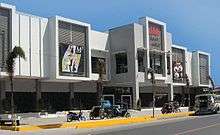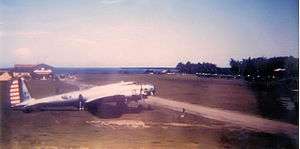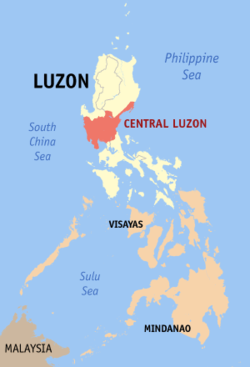Iba, Zambales
| Iba | ||
|---|---|---|
| Municipality | ||
 | ||
| ||
| Nickname(s): Seat of Provincial Government; Beach Capital of Zambales | ||
| Motto: Bagong Saya, Bagong IBA! | ||
 Map of Zambales showing the location of Iba | ||
.svg.png) Iba Location within the Philippines | ||
| Coordinates: 15°20′N 119°59′E / 15.333°N 119.983°ECoordinates: 15°20′N 119°59′E / 15.333°N 119.983°E | ||
| Country | Philippines | |
| Region | Central Luzon (Region III) | |
| Province | Zambales | |
| District | 2nd district of Zambales | |
| Founded | 1611 | |
| Barangays | 14 | |
| Government[1] | ||
| • Mayor | Rundy Ebdane | |
| • Vice-Mayor | Aireen Maniquiz-Biñan | |
| Area[2] | ||
| • Total | 153.38 km2 (59.22 sq mi) | |
| Population (2010)[3] | ||
| • Total | 46,761 | |
| • Density | 300/km2 (790/sq mi) | |
| Demonym(s) | Ibanian | |
| Time zone | PST (UTC+8) | |
| ZIP code[4] | 2201 | |
| Dialing code[4] | +63 (0)47 | |
| Income class | 1st class; partially urban[2] | |
| Website |
ibazambales | |
Iba is a first class municipality and the capital of the province of Zambales Philippines. According to the 2010 Philippine census, it has a population of 46,761 people. It is the second largest provincial capital in terms of land area in Central Luzon Region after Tarlac City. Iba is the birthplace of former Philippine President Ramon Magsaysay. With a continuously growing number of commercial establishments, banks, and financial institutions in Iba, it contends among the most competitive municipalities in Philippines, and is pushing forward towards a progressive city.
History
Iba was founded by the order of Augustinian Recollect priest in 1611 as the village of Paynauen.[5] The early inhabitants of the town are called Zambales. They were later joined by the Ilocanos who migrated to the town which resulted in intermingling of customs and traditions. The Aeta people settled in the hinterlands and the majority of them dwelled in the Mount Pinatubo area. In 1860, the administration of the town was turned over to the Dominican priests until the civil government came to power. There are no available records as to when Paynauen was renamed to Iba.[5]
The municipality was named after the sour fruit "Iba", commonly known as kamias (Averrhoa bilimbi), which is abundant in the place.[5] Local folklore talks about the Spaniards who came to the town asking the name of the place, the natives shouted "Iba, Iba" thinking that the man was asking what they were eating. From then on, the place was called Iba.
The permanent capital of Zambales was moved from Masinloc to Iba because of its strategic location being on the central part of Zambales. On August 28, 1901, American Civil Governor William Howard Taft held the historic session of the second Philippine Commission establishing the Province of Zambales under the American rule held at Roman Catholic Church of Iba.
Geography
The municipality of Iba is bounded by the municipalities of Botolan to the south, Palauig to the north, the province of Tarlac to the east, and the South China Sea to the west. Like most of the municipalities in the province, Iba is geographically bound by the coast in the west with the Zambales Mountains in the eastern portion of the municipality. Iba is 204 kilometres (127 mi) north-west of Manila.
Barangays
Iba is politically subdivided into 14 barangays.[2]
- Amungan (partly urban)
- Bangantalinga (rural)
- Dirita-Baloguen (partly urban)
- Lipay-Dingin-Panibuatan (rural)
- Palanginan (highly urban)
- San Agustin (rural)
- Santa Barbara (rural)
- Santo Rosario (rural)
- Zone 1 Pob. (highly urban)
- Zone 2 Pob. (urban)
- Zone 3 Pob. (urban)
- Zone 4 Pob. (urban)
- Zone 5 Pob. (urban)
- Zone 6 Pob. (urban)
Climate
Iba has a tropical monsoon climate (Köppen climate classification Am). Iba's climate is no different from the other towns where rainy season begins from June and ends in September, while the dry season is from October to May. An average of 43.15 centimetres (16.99 in) of annual rainfall with a temperature of 22 °C (72 °F) is observed during rainy season. The highest temperature recorded is 34 °C (93 °F) while the lowest is 19.18 °C (66.52 °F).
| Climate data for Iba, Zambales | |||||||||||||
|---|---|---|---|---|---|---|---|---|---|---|---|---|---|
| Month | Jan | Feb | Mar | Apr | May | Jun | Jul | Aug | Sep | Oct | Nov | Dec | Year |
| Average high °C (°F) | 31 (88) |
31 (88) |
32 (90) |
33 (91) |
33 (91) |
31 (88) |
30 (86) |
30 (86) |
30 (86) |
31 (88) |
31 (88) |
31 (88) |
31 (88) |
| Daily mean °C (°F) | 25 (77) |
26 (79) |
27 (81) |
28 (82) |
28 (82) |
27 (81) |
27 (81) |
26 (79) |
27 (81) |
27 (81) |
27 (81) |
26 (79) |
26 (79) |
| Average low °C (°F) | 20 (68) |
20 (68) |
21 (70) |
23 (73) |
24 (75) |
23 (73) |
23 (73) |
23 (73) |
23 (73) |
23 (73) |
22 (72) |
21 (70) |
23 (73) |
| Average rainfall mm (inches) | 4 (0.16) |
5 (0.2) |
11 (0.43) |
36 (1.42) |
252 (9.92) |
595 (23.43) |
853 (33.58) |
993 (39.09) |
605 (23.82) |
230 (9.06) |
96 (3.78) |
33 (1.3) |
3,712 (146.14) |
| Source: Weatherbase[6] | |||||||||||||
Demographics
| Population census of Iba | ||
|---|---|---|
| Year | Pop. | ±% p.a. |
| 1990 | 29,221 | — |
| 1995 | 31,503 | +1.42% |
| 2000 | 34,678 | +2.08% |
| 2007 | 44,344 | +3.45% |
| 2010 | 46,761 | +1.95% |
| Source: National Statistics Office[7][8][9] | ||
The population of Iba has become a mixture of different people over the last twenty years as opportunities in employment and business attracted people from Pangasinan, Bataan and Batangas. Originally, the population was composed of the Sambal and Ilocano speaking people. While Sambal and Ilocano are spoken by many of the population, Tagalog or Pilipino has become the common dialect spoken in Iba.
Religion
The majority of the people in Iba, Zambales are Roman Catholics. The largest minority religion is Iglesia Ni Cristo followed by various Protestant denominations.
Ecclesiastical District
The seat of the Ecclesiastical District of Zambales North of the Iglesia Ni Cristo is located in Iba. The INC district administration and district office oversees several locales and extensions from different municipalities in the northern part of Zambales province.
Diocese of Iba
The Cathedral of Iba, also known as the Cathedral of Saint Augustine, is the seat of the Roman Catholic Diocese of Iba. The church of the diocese is a 17th-century Baroque church built by the Augustinian Recollects. It is located adjacent to the Provincial Capitol Building. The current bishop of the diocese is Most Reverend Florentino G. Lavarias, D.D..
Economy


Being a center of employment and commerce as well being the host of major educational institutions, the population of Iba increase during day time because of traders, market buyers, students, government and private employees flocking in the town. Some of the newest establishments in Iba are Puregold and the Iba Town Center - the first and only community mall in the heart of Zambales.
Conversion to Cityhood
The League of Cities of the Philippines has the expanding disagreement in opinion against the conversion of sixteen municipalities into constituent cities. The LCP had tried to influence President Gloria Macapagal-Arroyo to certify as call for immediate attention a draft of a law imposing a suspension on the conversion of additional towns into cities.
Local Government Code states that before a town could be classified as a city, it must have an annual income of at least Php100 million and a land area of at minimum 100 square kilometres (39 square miles) or a population of 150,000.
Senator Angara advocates House Bill 24 filed by Zamboanga Sibugay Representative ANN Hofer giving automatic cityhood to capitals of provinces without cities by freeing the capital towns of provinces from the income needs of the cityhood.
Tourism
Tourism is one of the major economic activity in Iba during the summer period. It has become a popular destination for summer vacationists and tourists due to the pristine and beautiful beaches that line the shorelines of Iba, and adventure trekking to the unique 3-series of Iba waterfalls. Its pollution-free beaches due to the absence of industrial-polluting activities in the locality, make it one of the best places in the Philippines.
In response to the growing number of both local and foreign visitors, investments in beach resorts have increased in the last fifteen years. Today there are about 50 beach resorts in Iba.
Festivals

- Zambales Mango Festival
- The festival is a celebration of a bountiful harvest of mangoes and other agricultural products which the province is known for. It is also aimed to highlight the attractions and places of interest in all of its towns. As a way of promoting and giving thanks for a good harvest, the people of Zambales annually celebrate the six-day Mango Festival in March or April in Iba.[10]
- Paynauen Festival
- A summer festival in Iba featuring local traditional arts and culture first celebrated in the 1980s, Paynauen Festival (also spelled as Paynawen) has become a yearly tradition and a tourist attraction lasting for about seven days. Paynauen's festivities include street dancing, singing competition, boxing events, sports events, sand castle building, carabao race, kite flying contests, Miss Paynauen competition, cooking contest, barangay booth displays, products display and sales, ballroom dancing, traditional parade, concerts and many others.
- The festival is held late April, during the summer season where thousands of visitors flock to Iba for beach activities. Led by the Iba Tourism Council, Paynauen is supported by the local government, different civic organizations, volunteers and the private business sector.
Transportation

- By land
- Iba is easily reached from Manila and Pangasinan by land transportation. It is about 207 kilometres (129 mi) or a 3-hour drive from Rizal Park in Manila via North Luzon Expressway exiting in San Fernando, Pampanga to Olongapo. From Olongapo, Iba is about an hour away.[11]
- By air
- The town can be also reached by small aircraft using the Iba Airport, a small feeder airport with a 900-metre (3,000 ft) runway located along the coast of Iba.
Health centers
The provincial government administers the President Ramon Magsaysay Memorial Hospital in Bargy. Palanginan to provide convenient medical services at a lower costs to the people of the Zambales. The hospital received a ₱50-million equipment upgrade in 2011 to better serve its patients.[12][13]
The Sta. Cecilia Medical Center is a private institution offering one of the most complete and advance medical facilities in the province.[14]
Education
Tertiary education
The Ramon Magsaysay Technological University (RMTU), formerly Ramon Magsaysay Polytechnic College (RMPC), is a government-funded higher education institution founded in 1910. The school was merged with two other colleges in the province in 1998 to become the present multi-campus university system. Its main campus is located in the center of Iba with satellite campuses located all over the province.[15]
The provincial office of the Technical Education and Skills Development Authority (TESDA) in Zambales is located on Magsaysay Avenue. TESDA was established by the Philippine government to manage and supervise the vocational education and skills development of the country's human resources through training and scholarships.[16]
Popular culture
- The movie Apocalypse Now (shot in 1976; released in 1979) was about to be filmed by Francis Ford Coppola in Iba when Typhoon Olga (Didang) destroyed the sets constructed for the movie. The sets were recreated in Pagsanjan, Laguna and the beach scenes were filmed in Baler, Aurora.[17][18]
Local Government
| Elected Officials | |||
|---|---|---|---|
| Mayor | Jun Rundsted "Rundy" Ebdane | June 30, 2013 | 2nd Term |
| Vice-Mayor | Aireen Maniquiz-Biñan | June 30, 2016 | 1st Term |
| Member's Sangguniang Bayan | Frank Aldea | June 30, 2013 | 2nd Term |
| Badong Redondo | June 30, 2013 | 2nd Term | |
| Gerry Montefalcon | June 30, 2013 | 2nd Term | |
| Al Fallorin | June 30, 2013 | 2nd Term | |
| Danny Ballesteros | June 30, 2013 | 2nd Term | |
| Sixta Bangug | June 30, 2016 | 1st Term | |
| Gani Yap | June 30, 2016 | 1st Term | |
| Renato Abong | June 30, 2016 | 1st Term | |
References
- ↑ "Municipalities". Quezon City, Philippines: Department of the Interior and Local Government. Retrieved 25 March 2013.
- 1 2 3 "Province: Zambales". PSGC Interactive. Makati City, Philippines: National Statistical Coordination Board. Retrieved 26 March 2013.
- ↑ "Total Population by Province, City, Municipality and Barangay: as of May 1, 2010" (PDF). 2010 Census of Population and Housing. National Statistics Office. Retrieved 26 March 2013.
- 1 2 "Zambales Zip Codes and Area Codes". Philippine Zip Codes Directory. Retrieved on 2012-05-28.
- 1 2 3 "Municipalities". Zambales Now, Official Website of the Province. Retrieved on 2012-05-30.
- ↑ "Weatherbase: Historical Weather for Iba, Central Luzon, Philippines". Weatherbase. 2012. Retrieved 2013-05-12.
- ↑ "1995 Philippine Census Information". National Statistics Office of the Philippines. Retrieved on 2012-05-30.
- ↑ "2000 Philippine Census Information". National Statistics Office of the Philippines. Retrieved on 2012-05-30.
- ↑ "2007 Philippine Census Information". National Statistics Office of the Philippines. Retrieved on 2012-05-30.
- ↑ "Events/Festivals". Zambales Now, Official Website of Zambales. Retrieved on 2012-05-31.
- ↑ "Manila to Iba". Google Maps. Retrieved on 2012-05-28.
- ↑ Online (2012-01-21). "Zambales hospital acquires P50M equipment". Tempo. Retrieved on 2012-05-31.
- ↑ Bayarong, Anthony (2011-09-21). "Zambales hospital gets major upgrade worth P50 million". Sun Star Philippines. Retrieved on 2012-06-02.
- ↑ "Welcome to SCMC, Iba, Zambales". Sta. Cecilia Medical Center Official Website. Retrieved on 2012-06-02.
- ↑ "About us - RMTU at a Glance". RMTU Official Website. Retrieved on 2012-05-31.
- ↑ "Directory". Technical Education and Skills Development Authority. Retrieved on 2012-05-28.
- ↑ Webmaster (2012-05-23). "Apocalypse Now". The Worldwide Guide to Movie Locations. Retrieved on 2012-05-30.
- ↑ "Trivia: Apocalypse Now". Internet Movie Database. Retrieved on 2012-05-30.
External links
| Wikimedia Commons has media related to Iba, Zambales. |
- Official Website of Iba, Zambales
- Official Website of Zambales
- Local Governance Performance Management System - Iba,Zambales
- Iba Travel Guide
 |
Palauig |  | ||
| South China Sea | |
San Jose, Tarlac | ||
| ||||
| | ||||
| Botolan |

